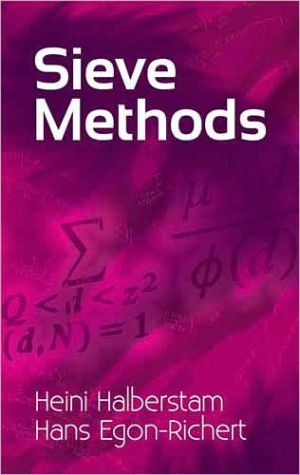

 |

|

Sold Out
Book Categories |
Preface to the Dover Edition iii
Preface v
Notation xi
Errata xv
Introduction 1
1 Hypotheses H and HN 1
2 Sieve methods 5
3 Scope and presentation 8
1 The Sieve of Eratosthenes: Formulation of the General Sieve 12
1 Introductory remarks 12
2 The sequences A 14
3 Basic examples 16
4 The sifting set B and the sifting function S 24
5 The sieve of Eratosthenes-Legendre 30
2 The Combinatorial Sieve 37
1 The general method 37
2 Brun's pure sieve 46
3 Technical preparation 52
4 Brun's sieve 56
5 A general upper bound O-result 68
6 Sifting by a thin set of primes 70
7 Further applications 75
8 Fundamental Lemma 82
9 Rosser's sieve 89
3 The Simplest Selberg Upper Bound Method 97
1 The method 97
2 The case ω(d) = 1, |Rd| ≤ 1 101
3 Application to 1 101
4 The Brun-Titchmarsh inequality 105
5 The Titchmarsh divisor problem 110
6 The case ω(p) = p/p-1 113
7 The prime twins and Goldbach problems: explicit upper bounds 116
8 The problem ap + b = p': an explicit upper bound 119
4 The Selberg Upper Bound Method (continued): O-results 130
1 A lower bound for G(x, z) 130
2 Applications 133
5 The Selberg Upper Bound Method: Explicit Estimates 142
1 A two-sided Ω2-condition 142
2 Technical preparation 143
3 Asymptotic formula for G(z) 147
4 The main theorems 152
5 Two ways of dealing with polynomial sequences {F(p)}: discussion 153
6 Primes representable by polynomials 157
7 Primes representable by polynomials F(p): the non-linearized approach 167
8 Prime k-tuplets 172
9 Primes representable by polynomials F(p): the linearized approach 180
6 An Extension of Selberg's Upper Bound Method 187
1 The method 187
2 An upper estimate 191
3 The function σκ 193
4 Asymptotic formula for G(ξ, z) 197
5 The main result 202
7 Selberg's Sieve Method (continued): A First Lower Bound 204
1 Combinatorial identities 204
2 Ah asymptotic formula for S 206
3 Fundamental Lemma 208
4 The function ηκ 211
5 A lower bound 213
6 The main result 218
8 TheLinear Sieve 223
1 The method 223
2 The functions F, f 225
3 An approximate identity for the leading terms 228
4 Upper and lower bounds for S 231
5 The main result 236
9 A Weighted Sieve: The Linear Case 241
1 The method 241
2 Application to the prime twins and Goldbach problems 247
3 The weighted sieve in applicable form 252
4 Almost-primes in intervals and arithmetic progressions 256
5 Almost-primes representable by irreducible polynomials F(n) 259
6 Almost-primes representable by irreducible polynomials F(p) 261
10 Weighted Sieves: The General Case 269
1 The first method 269
2 The first method in applicable form 277
3 Almost-primes representable by polynomials 282
4 The second method 291
5 Almost-primes representable by polynomials 310
6 Another method 315
11 Chen's Theorem 320
1 Introduction 320
2 The weighted sieve 321
3 Application of Selberg's upper sieve 327
4 Transition to primitive characters 330
5 Application of contour integration 334
6 Application of the large sieve 336
Bibliography 339
References 342
Login|Complaints|Blog|Games|Digital Media|Souls|Obituary|Contact Us|FAQ
CAN'T FIND WHAT YOU'RE LOOKING FOR? CLICK HERE!!! X
 You must be logged in to add to WishlistX
 This item is in your Wish ListX
 This item is in your CollectionSieve Methods
X
 This Item is in Your InventorySieve Methods
X
 You must be logged in to review the productsX
 X
 X

Add Sieve Methods, Derived from the techniques of analytic number theory, sieve theory employs methods from mathematical analysis to solve number-theoretical problems. This text by a noted pair of experts is regarded as the definitive work on the subject. It formulates the , Sieve Methods to the inventory that you are selling on WonderClubX
 X

Add Sieve Methods, Derived from the techniques of analytic number theory, sieve theory employs methods from mathematical analysis to solve number-theoretical problems. This text by a noted pair of experts is regarded as the definitive work on the subject. It formulates the , Sieve Methods to your collection on WonderClub |